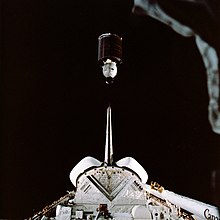Palapa

Palapais a series ofcommunications satellitesowned byIndosat,an Indonesian telecommunications company (formerly byPerumteland then by PT Satelit Palapa Indonesia/Satelindo). The first satellite was launched in July 1976, at which timeIndonesiabecame the first developing country to operate its own domestic satellite system.[1]The estimated cost for the project was US$1 billion (equivalent to $4.17 billion in 2023).[2][3]
History[edit]

The first satellite, Palapa-A1 of 300 kg (660 lb), was launched on 8 July 1976 at 23:31UTCfrom theKennedy Space Centerby aDelta 2914launch vehicle,or at 06:31Indonesian Timeon 9 July 1976.[4]Palapa-A2 was launched on 10 March 1977.
The name "Palapa" was bestowed by then Indonesian PresidentSuharto,after thePalapa oathsworn byGajah Mada,the Prime Minister ofMajapahitKingdom, in 1334.[4]According to thePararaton(Book of Kings), Gajah Mada swore that he would not taste anypalapa(historians suggest it refers to spice or a kind of flavouring) as long as he had not succeeded in unifyingNusantara(the Indonesian archipelago).[1]After watching the launching of the satellite via television in Jakarta, President Suharto revealed his reason on naming the satellite "palapa"; to show that Indonesia had a glorious past, and also hope that the system can unite the archipelago.[4]
Palapa-B1 was deployed by theSTS-7shuttle mission on 18 June 1983. Palapa-B2 was launched fromSTS-41-Bon 3 February 1984, to be put into service afterward, but the perigee kick motor (also known as thePayload Assist Module,or PAM) on the satellite failed during its approach to geosynchronous orbit, placing it at an improper and inoperablelow Earth orbit.It was retrieved on 16 November 1984 by theSTS-51Amission ofNASA'sSpace Shuttle,where it was brought back toEarth.The Space Shuttle mission to retrieve Palapa-B2, as well as the Westar-6 satellite which shared the launchpayloadwith Palapa-B2, was partially funded by theinsurancecompanies (led byLloyd's of London) who insured the launch of those two satellites.[5]Palapa-B2P was launched on 20 March 1987. Palapa-B2 was renamed as Palapa-B2R and launched on 13 April 1990. Palapa-B4 was launched on 14 May 1992.[6]
Palapa-C1 was launched on 1 February 1996, followed byPalapa-C2on 16 May 1996.
ThePalapa-Dsatellite was manufactured byThales Alenia Spaceand launched aboard aChineseLong March 3Blaunch vehicle on 31 August 2009. However, it failed to reach the intended orbit following a failure of the third stage of the launch vehicle to reignite as planned. TheSpacebussatellite buswas maneuvered into the correct geosynchronous orbit by September 2009, but this left it with only enough fuel for 10 years in orbit.[7]This US$200 million satellite (equivalent to $276 million in 2023)[3]has moretranspondersthan its predecessors (40 transponders, Palapa-C2 only has 36). 16 (40%) of its transponders are used by Indosat for their own purposes while the other 24 (60%) are rented to others. Indosat used Palapa-D for their broadband internet service (IM2) withKu-bandtechnology (12/14GHz).[8]At the end of October 2009, Palapa D started its airing operations.
Lighthouse project[edit]
The Palapa project was one of the "Lighthouse projects"instituted during theNew Orderperiod to build national pride. Other lighthouse projects during the New Order included transport infrastructure, theTaman Mini Indonesia Indahtheme park and the country’snational aircraft company.Most of these involved extravagant inauguration ceremonies with the officials who oversaw the projects in the spotlight. At the inauguration ceremony of the Palapa satellite system, President Suharto used a switch with 17 jewels (17 is the date of Indonesia'sProclamation of Independence) in the shape of a traditional dagger (kris). Besides symbolizing national unity and concretely helping to unite the country by serving its purpose as communication infrastructure, the satellite also tied advanced technology to Javanese tradition as epitomized by the inauguration ceremony.[9]
References[edit]
- ^ab"History of Palapa Satellite".PalapaSat. Archived fromthe originalon 29 April 2015.Retrieved14 April2015.
- ^Jones, R. (1976). "Satellite communications: Indonesia's bitter fruit".Pacific Research and World Empire Telegram.7(4): 1–6.
- ^abJohnston, Louis; Williamson, Samuel H. (2023)."What Was the U.S. GDP Then?".MeasuringWorth.Retrieved30 November2023.United StatesGross Domestic Product deflatorfigures follow theMeasuringWorthseries.
- ^abc"Planning and Development of Indonesia's Domestic Communications Satellite System PALAPA".Online Journal of Space Communication.Society for Satellite Professionals International (SSPI).Retrieved14 April2015.
- ^"Seven Things You Might Not Know You Can Insure".The One Brief, Aon. 2 February 2017.Retrieved19 October2017.
- ^"Palapa B1, B2, B2P, B2R, B4".Jet Propulsion Laboratory.NASA.Retrieved3 May2021.
 This article incorporates text from this source, which is in thepublic domain.
This article incorporates text from this source, which is in thepublic domain.
- ^"Indonesian Satellite Reaches Preset Orbit Despite Skewed Launch".Spacemart. 14 September 2009.Retrieved14 September2009.
- ^Thales Alenia Space Press releaseArchived2007-07-03 at theWayback Machine
- ^Barker, Joshua (December 2005). "Engineers and Political Dreams: Indonesia in the Satellite Age".Current Anthropology.46(5): 703–727.doi:10.1086/432652.S2CID149575825.
External links[edit]
- Gunter's Space Page - information onPalapa-B
- Palapa A at BoeingPalapa-A
- Palapa-C2 at Lyngsat
- Palapa-D at Lyngsat
